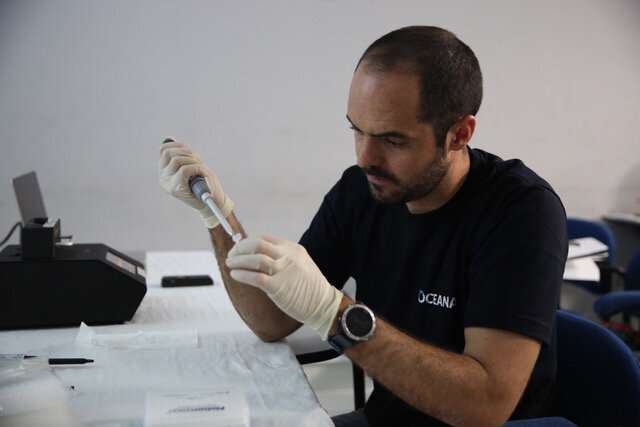Eastern Pacific is a major supply chain for illegal shark fin trade, researchers find

New research reveals the Eastern Pacific is a particular hotspot for the shark fin trade—and a danger zone for an endangered species fighting for survival.
Florida International University (FIU) postdoctoral researcher Diego Cardeñosa and Demian Chapman, an associate professor of biological sciences and marine scientist in the Institute of Environment, collaborated with scientists in Hong Kong to track and monitor the global shark fin trade using DNA testing.
They tested fins from endangered pelagic thresher sharks (Alopias pelagicus)—a species commonly found in the fin trade. Almost 85 percent of fins sampled from retail markets in Hong Kong and China were genetically traced back to sharks caught in the Eastern Pacific. It's not the first time the scientists have linked fins from endangered sharks to this specific area.
"The findings weren't surprising, because earlier this year we discovered the majority of fins from endangered scalloped hammerhead sharks also originated from the Eastern Pacific," Cardeñosa said. "This is a region with poor fisheries management and poor capacity to enforce international regulations."
The Eastern Pacific—which extends from Baja, California to Northern Peru—features island chains including the Galapagos and Cocos. The region attracts tourists. More recently, it's also attracted a growing presence of Chinese industrial fishing vessels, especially near the Galapagos. One of the primary reasons pelagic thresher shark populations are in steep decline is because of fishing practices that involve longlines and gillnets.
The researchers traced the fins back to the Eastern Pacific by comparing DNA from the fin trimmings in Hong Kong's markets to genetic samples that were previous collected from the region.
While pelagic thresher sharks are considered a single species, there are actually two "clades" or separate populations that exist. These groups don't intermingle. Instead, they mate within their specific clade. This means there are two different genetic populations—a Western group that resides in the ocean between Taiwan and Hawaii and an Eastern group, which roams between Hawaii eastward toward the coast of the U.S., Mexico, Costa Rica and Ecuador. The majority of the samples tested were from sharks that had belonged to the Eastern group.
Thresher sharks are protected under Convention on International Trade in Endangered Species of Wild Fauna and Flora (CITES)—an international agreement protecting animals and plants from over-exploitation in international trade. All trade of these sharks requires permits certifying they were legally caught and traceable through the supply chain. Since 2017, CITES permits have documented more than five tons of shark fins exported from the Eastern Pacific to Hong Kong. This only captures legal fishing operations. Alongside the legal trade, illegal trade is also happening.
"Our research pinpoints the Eastern Pacific as a major supply chain starting point for thresher sharks and other threatened sharks, and also a high-risk region for illegal trade," Cardeñosa said. "With what we know, we can begin to guide intervention efforts to monitor and enforce international laws. It's especially important to use all available technology and tools to detect and deter illegal trade of CITES-listed species."
Cardeñosa and Chapman remain committed to combating illegal trade with their DNA detective work. Earlier this year, Hong Kong customs officials intercepted an illegal shipment from Ecuador—in the Eastern Pacific—of 26 tons of thresher shark fins. The secret tool behind this historic seizure of shark fins was a DNA testing kit co-developed by Chapman and Cardeñosa. Created with funding from the Paul G. Allen Family Foundation, it's being used in airports and shipping ports to help customs officials identify protected shark species.
"There is a tendency for people to focus on the fin markets when looking for solutions to this problem, but our work shines light on the regions where most fins are coming from and hence where shark conservation and fisheries management could make a real difference on the ground," Chapman said. "We will only progress on global shark conservation by working throughout the supply chain—from ocean to markets."
The research is supported by the Pew Charitable Trusts and the Pew Fellowship Program. The findings were published in Animal Conservation. Cardeñosa was recently named a Distinguished Postdoctoral Fellow in the College of Arts, Sciences & Education.
FIU is ranked No. 9 in the world for positive impact on life below water by The Times Higher EducationImpact Rankings. The university ranked third in the United States and is the only institution in the state of Florida to make the list.
More information: D. Cardeñosa et al. Relative contribution to the shark fin trade of Indo‐Pacific and Eastern Pacific pelagic thresher sharks, Animal Conservation (2020).
Provided by Florida International University





















